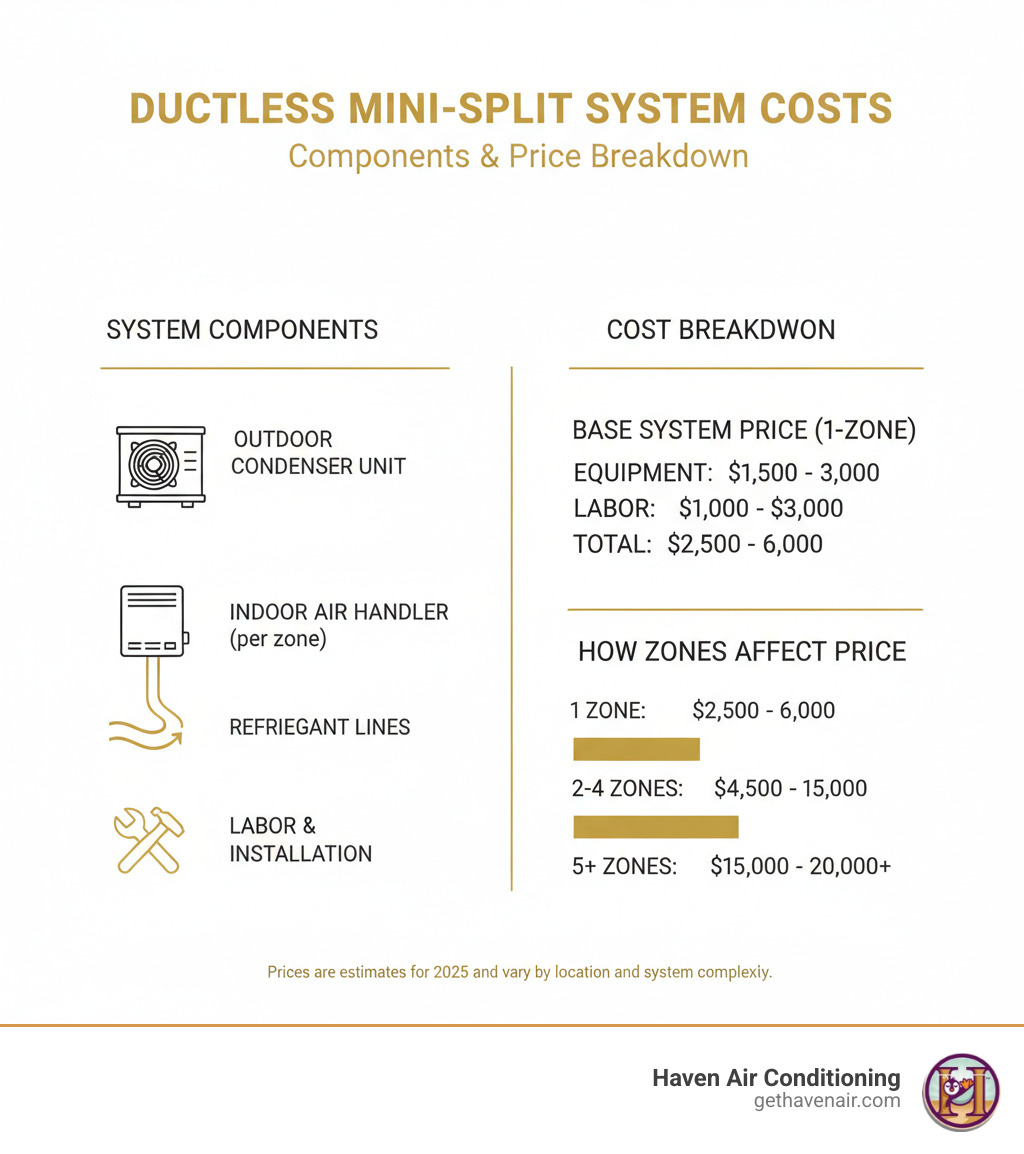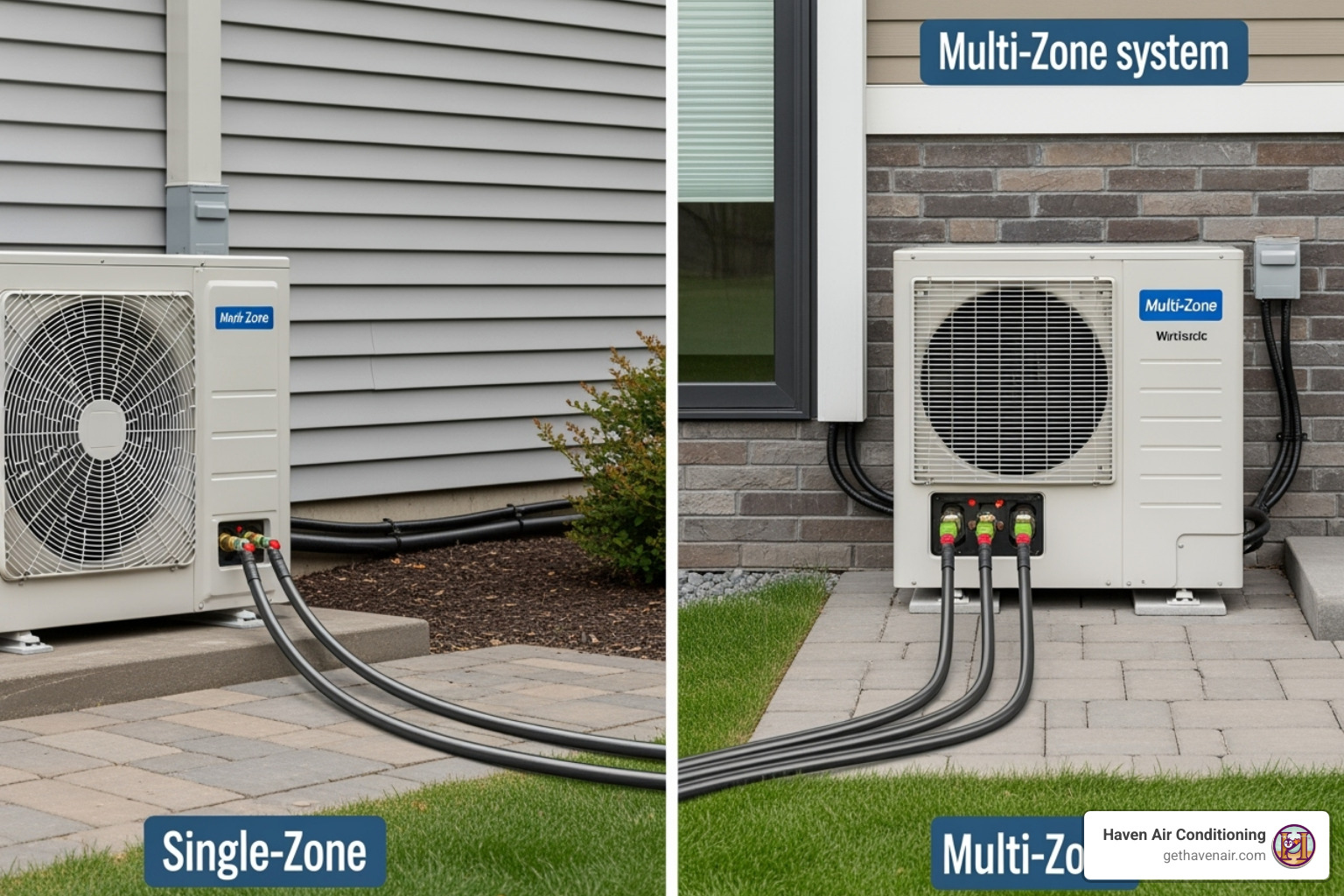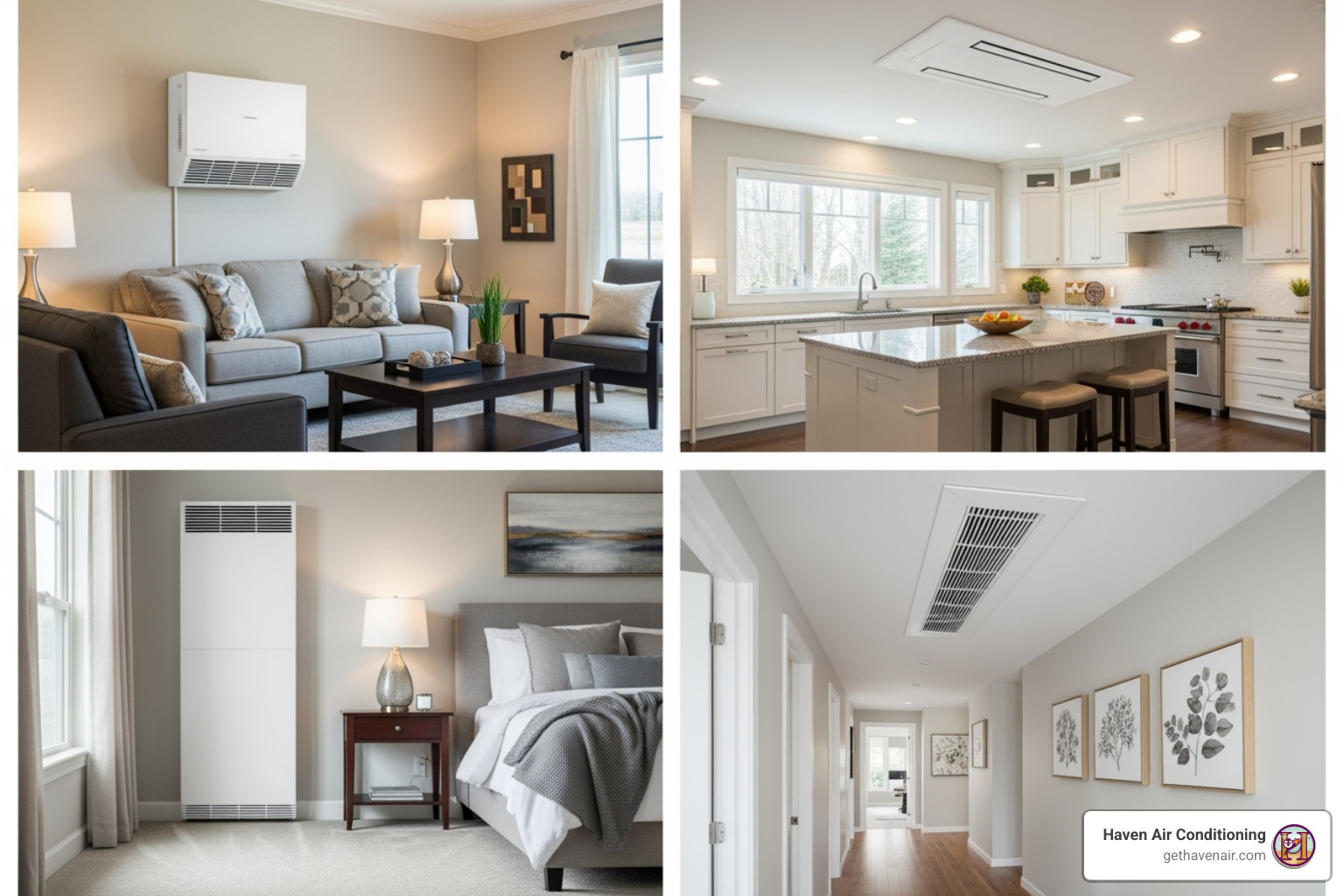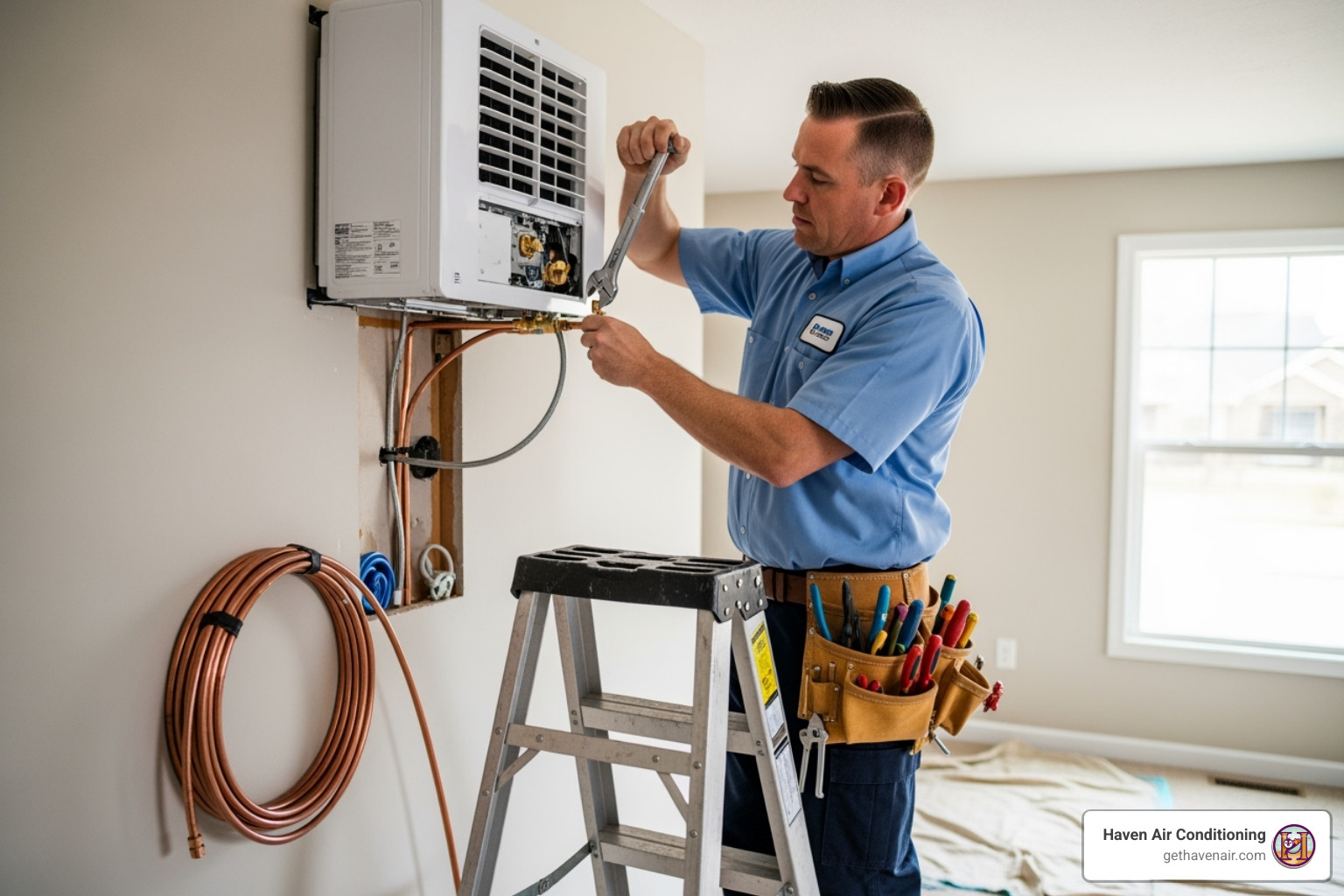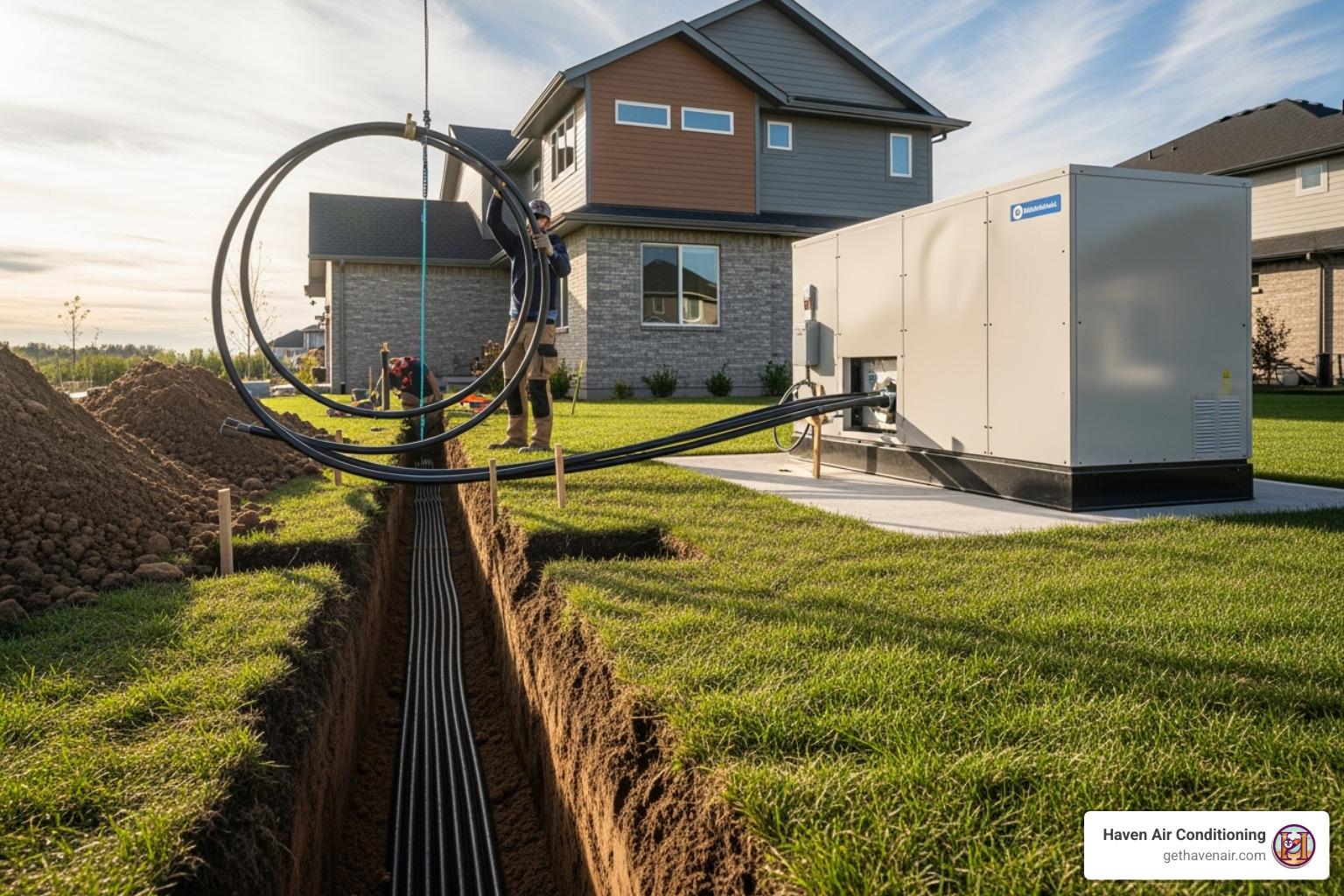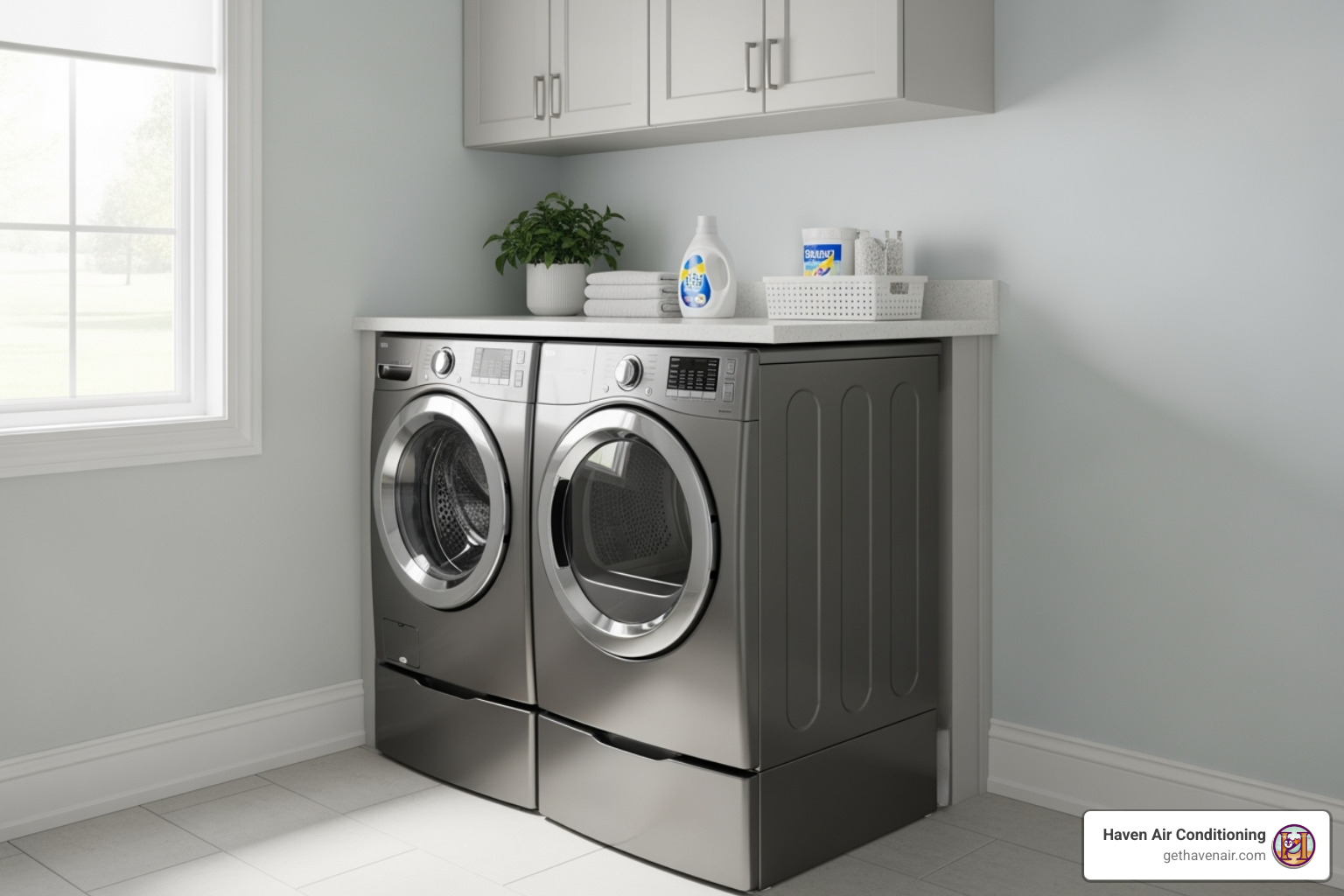Understanding the True Investment in Ductless Climate Control
Understanding what goes into a ductless HVAC system installation can feel complex when you’re researching options for your Orange County home. Whether you’re considering a sleek wall-mounted unit for a single room or a multi-zone system for your entire house, knowing what drives the scope of your project helps you make a smart decision. Here’s what you need to know:
Key Factors for Your System
- Number of Zones: The quantity of individual areas you want to control.
- System Capacity (BTUs): The heating and cooling power required for your space.
- Energy Efficiency: Higher ratings (SEER2/HSPF2) impact long-term savings.
- Indoor Unit Type: Different styles like wall-mounted or ceiling cassettes have different requirements.
- Installation Complexity: The unique layout of your home affects the installation process.
If your current HVAC system is struggling or you’re tired of uneven temperatures, ductless mini-splits offer a flexible, zoned comfort solution without the need for extensive ductwork. They are ideal for room additions, older homes, or spaces where traditional systems aren’t practical.
For comprehensive cooling solutions custom to your home, explore our cooling and air conditioning services, or get a professional consultation for mini-split installation to see what makes sense for your specific situation.
The scope of a ductless system project varies based on your home’s layout, the number of rooms you want to condition, and the efficiency level you choose. While the initial commitment might seem higher than a window unit, the long-term energy savings, improved comfort, and increased home value often make ductless systems a smart choice.
What to Expect with a Ductless Mini-Split System
When exploring ductless mini-split systems for your Orange County home, a primary consideration is understanding the overall project scope. While every home is unique, we can paint a clear picture of the factors involved.
Ductless HVAC projects vary widely based on your home’s unique needs, but understanding what’s involved helps you plan with confidence. Whether you’re cooling a single room or outfitting your entire home, knowing what influences your project makes the decision much easier.
The scope of your project depends heavily on whether you need a single-zone system for one room or a multi-zone setup to handle multiple areas. Your home’s size, layout, and comfort goals all play into the final project. For a deeper look at how ductless systems can transform your home’s comfort, visit our page on Ductless Cooling.
Understanding Project Scope
The variation in ductless HVAC project scopes isn’t random—it reflects real differences in what homeowners need. A straightforward single-zone installation for a smaller space, like a home office or master bedroom, will be different from a sophisticated multi-zone system that provides customized comfort throughout a larger home.
What affects the project scope? Equipment quality makes a significant difference, as higher-efficiency units with better warranties are more sophisticated. Your home’s size and the specific areas you want to condition directly impact the system capacity you’ll need. Finally, installation complexity can vary dramatically depending on your home’s construction and the desired unit locations.
Single-Zone vs. Multi-Zone Systems
The biggest factor affecting the scale of a ductless HVAC project is whether you choose a single-zone or multi-zone configuration.
A single-zone system heats or cools one specific area. This setup pairs one outdoor unit with one indoor air handler, making it perfect for targeting a sunroom, home office, or addition. Single-zone systems offer an efficient solution without the complexity of a whole-home installation.
Multi-zone systems provide a new level of comfort and flexibility. With one outdoor condenser connected to multiple indoor units, you can independently control the temperature in different rooms. This is ideal for families with different temperature preferences or for conditioning only the spaces you’re actually using.
This flexibility requires more comprehensive installation. Each additional zone means another indoor unit, more refrigerant lines, and additional installation labor. The outdoor condenser also needs greater capacity to handle multiple zones. The beauty of multi-zone systems is their efficiency—you’re not wasting energy on unused spaces. The comfort and potential energy savings often make multi-zone systems worthwhile. If you’re curious about how zone control can transform your home, our guide on Zone Control Benefits with Mini-Split AC dives deeper into the advantages.
Key Factors That Influence Your Ductless HVAC Project
When you start shopping for a ductless mini-split system, you’ll quickly realize that each project is unique. Several important elements determine the scope of your installation. Understanding these factors helps you make smart decisions and avoid surprises.
The main drivers include system size, the number of zones, energy efficiency, indoor unit style, and installation complexity. Here in Orange County, we see how these variables play out in homes just like yours. If you’re curious about what options are available, take a look at our Ductless AC in Anaheim, CA services.
System Size and Capacity (BTUs)
Getting the right size system is one of the most important decisions you’ll make. We measure a system’s capacity in BTUs (British Thermal Units), which indicates its heating or cooling power. Correctly sizing your system is the difference between a comfortable home and an inefficient system. Your specific needs depend on factors like ceiling height, insulation, window direction, and occupancy.
An undersized unit will run constantly, driving up energy bills while failing to keep you comfortable. Conversely, an oversized unit will cycle on and off too frequently, leading to a clammy feeling, uneven temperatures, and unnecessary wear. Systems with higher BTU capacities are more robust, but it’s important to match the system properly to your needs. Our guide on Proper Sizing for Home AC Split Mini Systems goes deeper into getting this right.
Single-Zone vs. Multi-Zone: How Zones Impact Your Project
The number of zones you choose has a dramatic impact on the project’s scope. Each indoor unit acts as its own thermostat, giving you independent temperature control and the potential for real energy savings. From a technical standpoint, a multi-zone system requires a more powerful outdoor condenser to handle multiple indoor air handlers. Each additional indoor unit brings its own equipment and labor considerations, as every zone needs its own refrigerant lines, electrical connection, and condensate drain. For homes with five or more zones, the equipment and labor become more extensive. Our article on Multi-Zone Mini-Split Installation provides a comprehensive look at these installations.
Energy Efficiency Ratings (SEER2 & HSPF2)
How efficiently your system operates affects your monthly utility bills. SEER2 (Seasonal Energy Efficiency Ratio 2) measures cooling efficiency, while HSPF2 (Heating Seasonal Performance Factor 2) measures heating efficiency. Higher numbers mean better efficiency and lower operating costs.
Many high-efficiency systems feature inverter compressors that precisely adjust their output, maintaining consistent temperatures while using less energy. More efficient systems typically feature advanced technology. The monthly utility bill savings add up significantly over the 15 to 20-year lifespan of the system. Look for the ENERGY STAR certification, which means the unit meets strict EPA efficiency guidelines. Homeowners who upgrade to highly efficient ductless heat pumps often see their heating costs drop dramatically.
Indoor Unit Types and Options
Ductless systems come in several indoor unit styles to fit different spaces and aesthetic preferences. Your choice affects the look, installation complexity, and overall project scope.
- Wall-mounted units are the most popular and usually the most straightforward to install.
- Floor-mounted units are an excellent alternative when wall space is limited.
- Ceiling-suspended units work well in large areas where wall space is at a premium.
- Recessed ceiling cassette units install flush with your ceiling for a discreet look, but installation is more involved.
- Vertical air handler units can be completely hidden in a closet, with ducted outputs to nearby rooms.
Each option has its place, and the right choice depends on your home’s layout, design preferences, and comfort priorities. The variety in ductless HVAC project scopes across these unit types reflects both equipment differences and varying installation requirements.
Understanding the Components: Equipment, Installation, and More
When you’re planning for a ductless mini-split installation, it helps to understand what’s involved. The total project isn’t just about the sleek unit on your wall—there’s a lot more happening behind the scenes.
Equipment Components: Indoor Units and Outdoor Condensers
The heart of your ductless system consists of the outdoor condenser and the indoor air handlers. The type of outdoor condenser unit you need depends on the number of rooms, total BTU capacity, and efficiency rating. The indoor air handler units come in various styles, and the number of units you need directly impacts your total equipment requirements. Many ductless systems also function as heat pumps, providing year-round comfort. To learn more about their heating capabilities, visit our Ductless Heating page.
Professional Installation Requirements
Professional installation isn’t just recommended—it’s essential. While DIY might seem tempting, ductless mini-split installation requires specialized expertise.
Professional installation ensures your system performs as designed. Technicians correctly size the system, handle refrigerant according to federal and state laws, make safe electrical connections, and test everything thoroughly. This expertise translates into better comfort, lower energy bills, and a longer system lifespan.
The risks of DIY installation are significant. Most manufacturers will void your warranty if you attempt self-installation. Incorrect wiring creates fire hazards, and improper refrigerant handling can lead to environmental damage and health risks. Homeowners who attempt DIY installation often end up needing professional repairs.
When you work with professionals, you gain peace of mind. For expert installation in your area, consider our services like Ductless AC in Irvine, CA.
Additional Components and Considerations
Beyond the main equipment and labor, several other components contribute to your complete installation. Understanding these helps you plan accordingly.
- Refrigerant line sets are the insulated copper lines connecting your outdoor and indoor units. Line set covers can be added for a cleaner appearance.
- Condensate drain lines carry moisture away from the indoor units to prevent water damage.
- An electrical upgrade may be necessary if your home’s existing panel or wiring cannot support the new system.
- Annual maintenance plans are a valuable way to keep your system running efficiently and catch small issues before they become problems.
- A small disposal fee may be included for safely removing and recycling any old equipment being replaced.
Long-Term Value: Efficiency, Savings, and Lifespan
When you’re considering a ductless system, the real story unfolds over the years you own it. The system delivers comfort, savings, and peace of mind throughout its lifespan. For more on how these systems can transform your living space, check out our insights on Space-Saving Ductless AC in Modern Homes.
Energy Savings and Efficiency Benefits
The energy savings from a ductless system can be genuinely impressive. Traditional central air systems can lose a significant amount of energy through leaky ducts. A ductless system has no ducts, so every bit of heating or cooling it produces goes directly where you need it.
The zoned approach makes an even bigger difference. You’re only conditioning the rooms you’re actually using, which translates to real savings. If you’re currently relying on space heaters, you know how expensive they are to run. A ductless heat pump provides consistent, efficient heating without those high electricity bills. For a consumer-friendly overview of typical space heater operating costs, see this CNET guide. Many homeowners who switch from older heating systems see their heating bills drop dramatically.
Lifespan and Maintenance
Your ductless system is a long-term solution. With proper care, these systems typically last between 15 and 20 years, and sometimes longer. The key is regular maintenance.
Cleaning or replacing your indoor unit filters is the easiest thing you can do to maintain good airflow and high indoor air quality. Annual professional servicing is equally important. A technician can spot minor issues before they become problems and keep your system running at peak efficiency. This preventive care protects your system. If you’re not sure what to watch for, our page on Warning Signs a Ductless AC Needs Attention can help.
Rebates, Tax Credits, and Financing
We understand that planning for a new system requires consideration. The good news is there are often several programs designed to help.
The federal government periodically offers tax credits for installing qualifying energy-efficient heat pump systems. Your local utility company is also an excellent resource for rebates. State and local government programs and manufacturer promotions can provide additional incentives.
Finally, financing options make it easier to manage your project. Many HVAC providers, including us at Haven Air Conditioning, offer financing for qualifying purchases. This allows you to enjoy the comfort and savings of your ductless system immediately while managing payments in a way that fits your budget.
Frequently Asked Questions about Ductless HVAC Systems
Homeowners exploring ductless options often have similar questions. Here are the answers to some of the most common inquiries we receive about ductless HVAC systems.
How does a ductless system compare to traditional central air?
It’s helpful to look at the complete picture. If your home already has ductwork, installing central air might seem straightforward. However, if you don’t have existing ducts, installing a new duct system can be substantial. Ductless systems sidestep this issue entirely.
Where ductless systems truly shine is in operating efficiency. They deliver conditioned air directly into each room, avoiding the energy losses that plague central systems. The zoning capabilities add another layer of savings, as you only condition the rooms you’re using. The long-term energy savings and improved comfort often make ductless the smarter choice.
Should I attempt a DIY installation?
We strongly advise against DIY installation. It requires specialized skills, tools, and legal requirements for handling refrigerant. The risks of getting it wrong are significant. Incorrect connections can lead to leaks, improper electrical work poses serious fire hazards, and mistakes can permanently damage expensive components.
Perhaps the biggest concern is your warranty. Almost every manufacturer requires professional installation by a licensed HVAC technician to keep your warranty valid. Professional installation protects your system, ensures safety and efficiency, and gives you peace of mind.
Does a mini-split need to be installed in every room?
Absolutely not. One of the most appealing aspects of ductless mini-splits is their flexibility. You can choose which specific areas receive climate control based on how you live in your space. A single, strategically placed indoor unit can often keep an entire open-plan living area comfortable.
We focus on identifying the key areas where comfort matters most, such as bedrooms, living rooms, and home offices. There’s no need to include spaces that sit empty or don’t require precise temperature control. This selective approach helps you achieve comfort exactly where you need it. For more insights, check out our guide on Ductless AC Placement Maximizes Home Comfort.
Conclusion
When you’re exploring ductless HVAC options, it’s important to look at the complete picture—the equipment, the installation expertise, the energy efficiency, and how many zones your home actually needs. Every Orange County home is unique, and your comfort solution should be too.
A ductless system is a long-term solution for your home. The energy savings that accumulate month after month, the ability to personalize comfort in each room, and a system that can serve your family reliably for 15 to 20 years or more make it a worthwhile addition to your home.
At Haven Air Conditioning, we understand that choosing the right climate control system is about more than just specifications. It’s about understanding your family’s needs, your home’s layout, and your comfort goals. Our professionals take the time to evaluate your specific situation and provide honest, expert guidance.
Ready to discover what a ductless system could mean for your home’s comfort and your monthly energy bills? We’re here to answer your questions and provide a detailed consultation custom to your Orange County property.
Get a professional consultation for your Mini-Split AC Installation


